As Donald Trump prepares to take the oath of office for his second term, all eyes are on the plethora of executive orders he plans to sign on his inauguration day. Early indications suggest that the former president is set to implement an unprecedented number of directives, potentially exceeding 100, aimed at reshaping significant sectors of American policy. This article delves into the anticipated implications of Trump’s executive actions and the political landscape they will impact.
The signing of executive orders is a traditional tool for presidents to bypass potential legislative gridlock, a reality Trump experienced during his first term in office. By opting to issue a substantial number of orders directly after his inauguration, Trump positions himself to rapidly address issues that resonated with his voter base during the campaign. This approach indicates a deliberate strategy to signal his administration’s priorities while asserting authority over policy changes without the need for congressional approval.
Trump’s transition team has indicated that the slate of executive orders will include a mixture of revocations of previous policies instituted by President Joe Biden, promises made during Trump’s campaign, and reforms designed to reorganize the federal workforce. Such a multifaceted strategy is evident of a leader determined to set a new tone immediately, which may also unsettle those who view this approach as undermining the traditional legislative process.
Border Security at the Forefront
One of the most highly anticipated executive actions is Trump’s plan to declare a national emergency concerning the U.S.-Mexico border. This move reflects Trump’s consistent emphasis on border security as a pivotal aspect of his policies. During a recent rally in Washington, Trump claimed that his administration would take decisive action to halt illegal immigration. The emphasis on a border emergency is not just symbolic; it signals a commitment to dismantling current immigration policies that are perceived as lenient.
This is reminiscent of Trump’s first term where he sought to redirect military funds toward the construction of a border wall, a contentious issue that faced numerous legal challenges. Trump clearly intends to pick up where he left off, which suggests a potential resurgence in heated debates surrounding immigration enforcement and the rights of individuals crossing the border.
Another significant aspect of Trump’s forthcoming executive orders includes the proposed withdrawal of funding from climate-related initiatives established in Biden’s Inflation Reduction Act. This decision could prompt legal challenges, given the stipulations outlined in the Impoundment Control Act of 1974, which mandates that appropriated funds must be utilized as designated by Congress. The discussions surrounding this move could spark a re-examination of executive power and its limits, especially regarding the management of congressionally approved funding.
Trump’s assertion that his new nominee for the Office of Management and Budget does not view this law as constitutional signals a contentious path ahead. How the courts will interpret these executive overreach claims remains an open question.
Revisiting “Schedule F” and Workforce Restructuring
Another focal point in Trump’s inaugural actions includes the reimplementation of the “Schedule F” initiative, which seeks to reclassify federal jobs. This policy would enable Trump to appoint loyalists to positions traditionally protected from political influence, allowing him to fill roles with individuals who are more aligned with his administration’s goals. The implications of this move are significant; it can lead to criticisms about politicization within federal institutions and further polarize the political climate.
As Trump outlines his planned directives, the implications for federal employees and long-term workforce policies are profound. Many in the civil service may view this as a direct threat to their autonomy and the integrity of nonpartisan public service.
Political Ramifications and Public Response
Given the urgency and the controversial nature of these initial policies, Trump’s administration might face immediate pushback from both political opponents and segments of the public. The strategic choice to unveil these orders amidst inclement weather and modified celebration plans also raises questions about the broader acceptance of these policies. Will the American public rally behind these actions, or will this set the stage for renewed protests and political division?
As Trump steps back into the limelight and implements his ambitious plans, the repercussions of these executive actions will resonate throughout the fabric of American governance and society. Whether he can maintain momentum while navigating the hurdles ahead will be critical in shaping his second term’s legacy. Only time will tell if these initial gambits will yield the stability, loyalty, and support Trump aims to garner, or create further contention in a polarized nation.


Leave a Reply